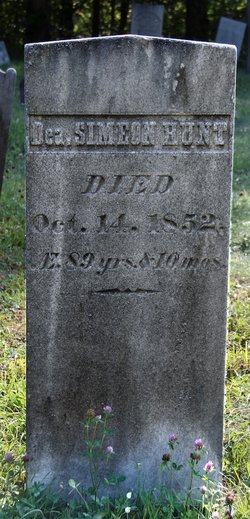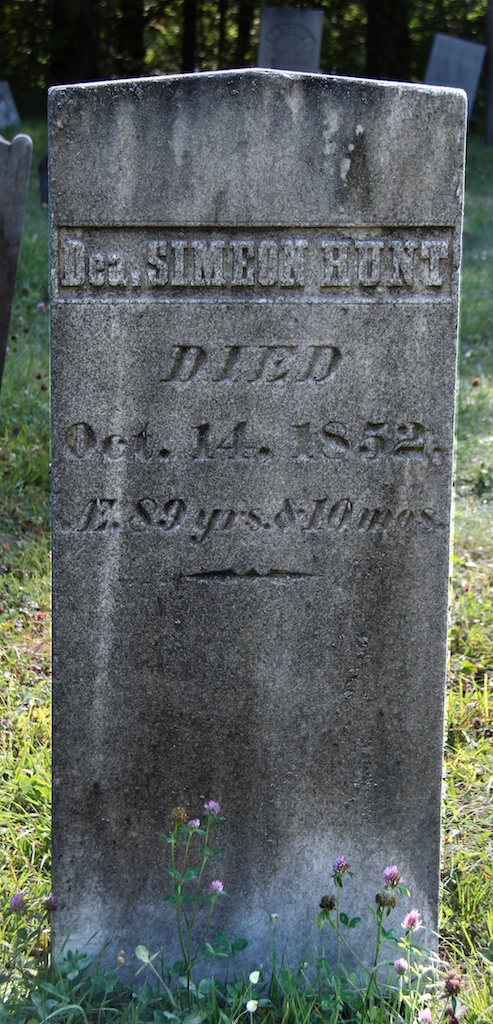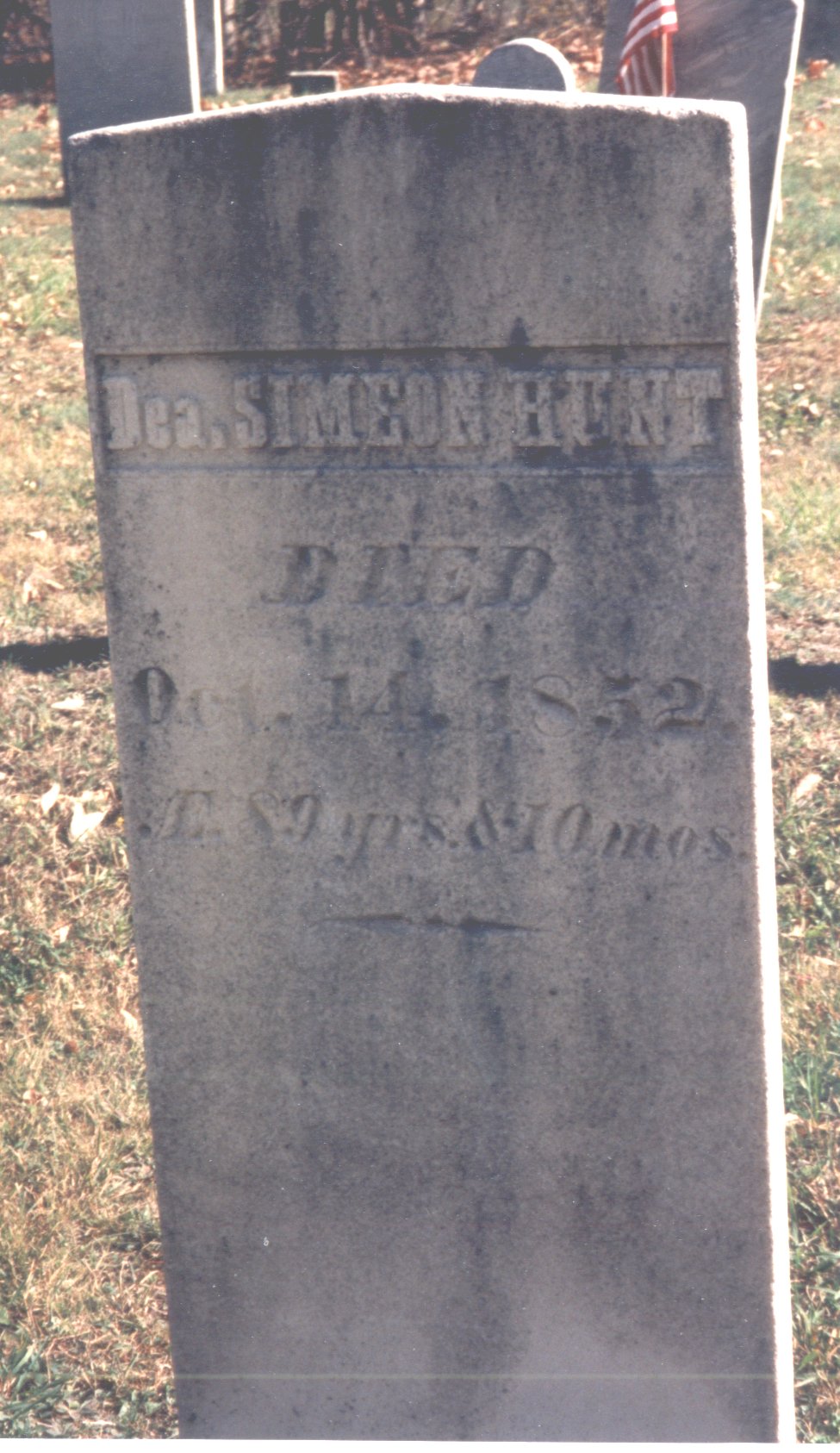After the death of Ruth, Deacon Simeon married, on March 17, 1816, Elizabeth Folsom. He died Oct. 14, 1852, in his 90th year, and she died Nov. 17, 1864, in her 85th year. They are buried in the Hunt Cemetery in North Tunbridge, as is also his first wife, Ruth, and his father and mother Elizabeth Folsom; b. July 30, 1780 in Gilmanton, New Hampshire.
The Hunt homestead is situated in the northern part of Tunbridge, close to Chelsea. It is east of the "Branch Road", up on top of the hill. The original house is no longer there, but there are traces of it. It is on the summit of a knoll just N. E. of the second house. After his second marriage, Simeon Hunt and his family occupied the house which is now owned, (in 1935), by James How, and occupied by the family of Clarence Folsom. I was told that at one time the Hunts owned most of the land on top of that hill, except what was owned by the Smith's.
In politics Simeon Hunt was a Whig. In religion he was a Free-will Baptist. The church the Hunts attended in early years was a brick building up on the hill. It has been torn down. In later years they attended what is now the Universalist church in the village of North Tunbridge. During Deacon Hunt's last years it was a Union Church. Mrs. Royal Smith, who died in the summer of 1935, aged almost a hundred, told us when we called on her in 1932, that she remembered Simeon Hunt well. (They both lived to such a ripe old age that their lives overlapped sixteen years. Bob had the unique pleasure of shaking hands with a woman who had known one of his Revolutionary War ancestors!) Mrs. Smith told us that he was a very good and kind old man. When she was a girl, he was bald on top of his head. When in church he used to spread a large red silk handkerchief over the bald spot to keep off the drafts. She once had a scolding from him; it was during an annual meeting, when a stranger was addressing the assembly. He was an uneducated man and made many mistakes in pronunciation. When he told how he had received a letter from a relative who lived in the State of Philadelphia, it was too much for Mrs. Smith and her young girl companions. They giggled. After the speaker was through, Deacon Hunt, a shaky, old man with a quavery voice, rose up and gave them a good "talking to". She never forgot that scolding.
Mrs. Delia Dickerman, a daughter of Penelope Hunt, told me this about her grandfather Simeon Hunt. During the "cold year" of 1816, when snow fell every month of the year in New England, seed corn was very scarce and much hardship resulted. Simeon Hunt had a supply which he doled out to his neighbors as fairly as he could. None of his own family had corn to eat except his wife. It was just before the birth of Penelope, Cousin Delia's mother. Cousin Delia says her mother never could get enough corn meal to satisfy her, and she thinks it was the result of her mother getting such a meager supply. Evidently Simeon Hunt was a public spirited citizen.
When Uncle Ormond Hunt (Ormond Edson's uncle) wanted to join the S. A. R., the expert whom he employed to look up the matter for him could not find that any of his ever-so-greats by the name of Hunt had been in the Revolution. Daniel was too old and Simeon was apparently too young. Uncle Ormond joined the Society on the Revolutionary record of Dr. Jabez Cowdrey, father of Simeon's wife, Ruth. But Mrs. Flora Meakins, a granddaughter of Ruth Hunt joined on the record of Simeon Hunt. When he was nineteen he substituted for Elijah Hunt of Woodbury, Connecticut, which is near Sharon. The Hunt Genealogy shows that Simeon had two first cousins of that name. His uncle Stephen Hunt of Lebanon had a son Elijah, and this Elijah was married and had three very small children at the time Simeon went into the army. The other one was the son of his uncle Simeon Hunt of Coventry. This Elijah was a trifle older on than Simeon. Sometime during the Revolution he was a prisoner on board an English ship in New York harbor. Which cousin it was whose place he took, is more than I can guess.
The cousins in Vermont told me that they thought Deacon Simeon was short and slight and sandy-haired. We have a daguerreotype of him which must have been taken not long before he died in 1852. We have no picture of his wife Ruth. She died twenty-five years before photographs were invented. It is said, though, that the Cowdery girls were all fine-looking, dressed well and were the belles of the town.
children of Simeon & Ruth:
Ormond (1794-1861), Clarissa (1796-1864), Burnham (1798-1882), Garretson (1800-1860), John (1803-1887), Amanda (1809-1847), and Harriet (1813-1813)
children of Simeon & Elizabeth:
Penelope (1817-1906), Ruth (1819-1878), Elizabeth Caroline (1822-1855), Naomi (1824-1906)
From the notes of Irene May (Stringer) Hunt, wife of John Herman Hunt, a 2nd great grandson of Simeon, written in 1935
After the death of Ruth, Deacon Simeon married, on March 17, 1816, Elizabeth Folsom. He died Oct. 14, 1852, in his 90th year, and she died Nov. 17, 1864, in her 85th year. They are buried in the Hunt Cemetery in North Tunbridge, as is also his first wife, Ruth, and his father and mother Elizabeth Folsom; b. July 30, 1780 in Gilmanton, New Hampshire.
The Hunt homestead is situated in the northern part of Tunbridge, close to Chelsea. It is east of the "Branch Road", up on top of the hill. The original house is no longer there, but there are traces of it. It is on the summit of a knoll just N. E. of the second house. After his second marriage, Simeon Hunt and his family occupied the house which is now owned, (in 1935), by James How, and occupied by the family of Clarence Folsom. I was told that at one time the Hunts owned most of the land on top of that hill, except what was owned by the Smith's.
In politics Simeon Hunt was a Whig. In religion he was a Free-will Baptist. The church the Hunts attended in early years was a brick building up on the hill. It has been torn down. In later years they attended what is now the Universalist church in the village of North Tunbridge. During Deacon Hunt's last years it was a Union Church. Mrs. Royal Smith, who died in the summer of 1935, aged almost a hundred, told us when we called on her in 1932, that she remembered Simeon Hunt well. (They both lived to such a ripe old age that their lives overlapped sixteen years. Bob had the unique pleasure of shaking hands with a woman who had known one of his Revolutionary War ancestors!) Mrs. Smith told us that he was a very good and kind old man. When she was a girl, he was bald on top of his head. When in church he used to spread a large red silk handkerchief over the bald spot to keep off the drafts. She once had a scolding from him; it was during an annual meeting, when a stranger was addressing the assembly. He was an uneducated man and made many mistakes in pronunciation. When he told how he had received a letter from a relative who lived in the State of Philadelphia, it was too much for Mrs. Smith and her young girl companions. They giggled. After the speaker was through, Deacon Hunt, a shaky, old man with a quavery voice, rose up and gave them a good "talking to". She never forgot that scolding.
Mrs. Delia Dickerman, a daughter of Penelope Hunt, told me this about her grandfather Simeon Hunt. During the "cold year" of 1816, when snow fell every month of the year in New England, seed corn was very scarce and much hardship resulted. Simeon Hunt had a supply which he doled out to his neighbors as fairly as he could. None of his own family had corn to eat except his wife. It was just before the birth of Penelope, Cousin Delia's mother. Cousin Delia says her mother never could get enough corn meal to satisfy her, and she thinks it was the result of her mother getting such a meager supply. Evidently Simeon Hunt was a public spirited citizen.
When Uncle Ormond Hunt (Ormond Edson's uncle) wanted to join the S. A. R., the expert whom he employed to look up the matter for him could not find that any of his ever-so-greats by the name of Hunt had been in the Revolution. Daniel was too old and Simeon was apparently too young. Uncle Ormond joined the Society on the Revolutionary record of Dr. Jabez Cowdrey, father of Simeon's wife, Ruth. But Mrs. Flora Meakins, a granddaughter of Ruth Hunt joined on the record of Simeon Hunt. When he was nineteen he substituted for Elijah Hunt of Woodbury, Connecticut, which is near Sharon. The Hunt Genealogy shows that Simeon had two first cousins of that name. His uncle Stephen Hunt of Lebanon had a son Elijah, and this Elijah was married and had three very small children at the time Simeon went into the army. The other one was the son of his uncle Simeon Hunt of Coventry. This Elijah was a trifle older on than Simeon. Sometime during the Revolution he was a prisoner on board an English ship in New York harbor. Which cousin it was whose place he took, is more than I can guess.
The cousins in Vermont told me that they thought Deacon Simeon was short and slight and sandy-haired. We have a daguerreotype of him which must have been taken not long before he died in 1852. We have no picture of his wife Ruth. She died twenty-five years before photographs were invented. It is said, though, that the Cowdery girls were all fine-looking, dressed well and were the belles of the town.
children of Simeon & Ruth:
Ormond (1794-1861), Clarissa (1796-1864), Burnham (1798-1882), Garretson (1800-1860), John (1803-1887), Amanda (1809-1847), and Harriet (1813-1813)
children of Simeon & Elizabeth:
Penelope (1817-1906), Ruth (1819-1878), Elizabeth Caroline (1822-1855), Naomi (1824-1906)
From the notes of Irene May (Stringer) Hunt, wife of John Herman Hunt, a 2nd great grandson of Simeon, written in 1935
Inscription
age 89
Family Members
Advertisement
Advertisement

















